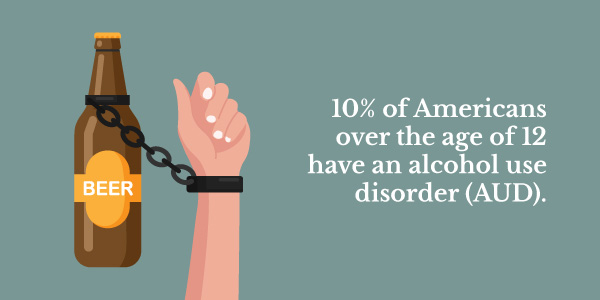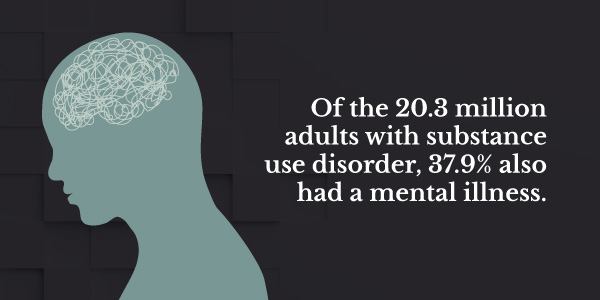Complete Guide: Types of Substance Abuse
What Is Substance Abuse?
Substance abuse is considered excessive or uncontrolled use of substances such as alcohol, pain medications, or other illegal drugs. A substance use disorder diagnosis may be made if there continues to be uncontrolled substance abuse, dependence, and tolerance. This disorder occurs when an individual continues to use drugs or alcohol in an excessive or uncontrolled way despite experiencing negative consequences due to the substance misuse. 1

Contact Profound Treatment to Learn More
Our team is standing by to discuss treatment options with you. Your call is completely confidential and no obligation is required.
Substance Abuse vs. Substance Use Disorder
Substance abuse is different from a substance use disorder. Substance abuse is defined as the over usage or misuse of a substance, but it generally is not causing pervasive problems in one’s life. With substance abuse, individuals may usually find it fairly easy to stop using, but this can quickly turn into the inability to stop if one isn’t mindful. On the other hand, a substance use disorder is an official diagnosis given to someone who displays signs of persistent addiction and is unable to stop using. 2
What is Addiction?
Understanding Addiction
How Might Substance Use Disorder Affect Me?
Behavioral or Mental Health Changes
- Unexplained changes in behavior or personality
- Lack of motivation
- Changes in appetite or sleep patterns
- Engaging in risky behaviors despite knowledge of the negative consequences
- Difficulty completing tasks at work, school, or home
- Extreme cravings for the substance
- Sudden mood swings, irritability, or agitation
- Experiencing periods of depression, anxiety, hyperactivity, or paranoia
- Financial issues
Physical Changes
- Bloodshot or tired eyes, and abnormally sized pupils
- Sudden weight loss or gain
- Tremors or slurred speech
- Impaired coordination
- Deterioration of physical appearance
What Are the Different Types of Substance Abuse?
Alcohol
Alcohol Addiction
Tobacco or Nicotine
Opioids
Stimulants
Types of substance addictions to stimulants can include cocaine, methamphetamine, and amphetamines. About one million people meet cocaine use disorder criteria, and almost two million people meet criteria for a methamphetamine use disorder. Some stimulant use disorder symptoms may include heart problems, increased anxiety and depression, paranoia, or psychosis.6
Hallucinogens
Cannabis
What Are the Signs and Symptoms of Substance Abuse?

- Continued use despite knowing the disorder is causing negative consequences to your life
- Taking the substance for longer than intended
- Craving the substance or behavior
- Regular overconsumption
- Worrying about overuse but being unable to stop
- Using in situations that may not be safe, such as driving under the influence
- Giving up previously enjoyed activities due to use
- Spending a lot of time using or trying to use and recovering
- Neglecting responsibilities at home, work, or school
- Building up a tolerance and needing to use more over time
- Experiencing withdrawal symptoms when trying to quit
How Is Substance Abuse Diagnosed?
Causes of Substance Abuse
Environmental Factors
- Tense home environment, or an environment where parents also used substances
- Financial difficulties
- Lack of parental attachment in childhood
- Relationship issues
- Divorce or loss of a loved one
- Exposure to a peer group or environment that uses
Genetic or Physical Factors
- Family history of addiction
- Sleep problems
- Chronic pain
- Long-term tobacco habit
Risks of Substance Misuse
Risk Factors
- Physical Health Problems: People with chronic pain, physical issues, or sleep problems may be at risk of misusing substances in order to alleviate suffering.
- Mental Health Problems: Mental health and substance misuse are very often co-occurring. According to the National Institute of Drug Abuse, of the forty-two million adults with mental health issues, 18.2% of those had a substance use disorder diagnosis. 9
- Risky or Dangerous Behavior: Engaging in risky or dangerous behavior can be a risk factor for substance-related disorders. Those who engage in risky behaviors are more likely to also associate with individuals who misuse drugs or alcohol.
- Legal Risks: Legal risks can cause a massive amount of stress, which can increase the rate of drug or alcohol misuse in order to deal with difficult situations or emotions.
Effects of Substance Abuse

- Can increase the risk of psychotic behavior or death due to overdose
- There is an increased risk for communicable diseases, such as Hepatitis and HIV, due to potential risky sexual behavior or needle sharing.
- Can cause heart problems, liver and kidney damage, increased depression and anxiety, etc.
- There is an increased risk of driving under the influence.
- Higher suicide risks
- Family and relational problems are more likely to occur, including custody issues, divorce, and family conflict.
- Can cause problems at work, home, or school.
- Legal problems are also a common effect of substance abuse, which may be due to the buying, selling, or possession of illegal substances, as well as driving while under the influence.
- Financial problems are also more likely to occur, causing debt or engagement in illegal behaviors to obtain either money or the substance.
Treatment Options For Substance Use Disorder
There is no single cure for addiction or substance use disorder. However, there are many types of treatment options available for substance use disorders. Substance use disorder treatment usually involves a combination of detox, individual therapy, group therapy, and engagement in self-help programs like AA or NA.
Withdrawal or Detox
Inpatient Rehab
Substance use disorder treatment may also include inpatient rehab. Inpatient rehab requires the individual to check into a controlled and stable environment to help manage their substance use. Typically, inpatient rehab programs last anywhere from one to three months, and some programs may even last up to one year.
Outpatient Rehab
Types of Outpatient Programs
- Standard Outpatient Program: A standard outpatient program typically involves attending individual or group therapy sessions one to two times per week.
- Intensive Outpatient Program (IOP): IOP is more intense and involves attending sessions anywhere from three to five days a week, with each session lasting three or four hours. Services during IOP may include a combination of individual therapy, group therapy, family therapy, and medication management.
- Partial Hospitalization Program (PHP): PHP is the highest level of outpatient program and typically involves attending treatment for four to six hours per day for three to five days per week. PHP is often used as a step-down after an inpatient treatment program.
Psychological Therapies

- Motivational Interviewing (MI): MI is an evidenced-based approach that involves collaborative and goal-setting communication. It is designed to help strengthen a person’s motivation for and commitment to overall change by exploring reasons for change. 11
- Motivational Enhancement Therapy (MET): MET is a short-term technique that is aimed at helping people improve their motivation to change harmful and destructive behaviors. This can be done by helping people view behaviors more objectively and empowering them to change.
- Prize-Based Contingency Therapy: Prize-based contingency management is a form of treatment that involves providing individuals with rewards for drug and alcohol-free behaviors. This means reinforcing positive behaviors, like providing a negative drug test, with prizes that are often monetary such as vouchers or cash.
- Seeking Safety: Seeking Safety is a therapeutic program aimed at treating individuals with trauma, PTSD, or substance abuse by focusing on safe coping skills.
- Guided Self-Change: This therapy integrates cognitive-behavioral therapy, MI, and relapse prevention to help individuals develop their own plans for change.
Behavioral Therapies
Behavioral therapies of substance abuse are those treatments that are aimed at making changes to how individuals think, feel, and act. These therapies look to identify and change unhealthy thinking and behavior patterns.
Cognitive-Behavioral Therapy (CBT)
CBT is an extremely popular, evidenced-based therapy that combines the focus on patterns of behavior with patterns of thought. The main focus of CBT is on how your thoughts influence your emotions and behaviors. The goal for treatment is to identify and change negative thinking patterns and replace them with more positive, adaptive patterns to improve feelings and behaviors.
Dialectical-Behavior Therapy (DBT)
DBT is a form of cognitive-behavioral therapy that focuses on regulating difficult and uncomfortable emotions. The four core elements of DBT involve teaching mindfulness, creating interpersonal effectiveness to improve relationships, learning emotion regulation, and utilizing distress tolerance skills.
Understanding DBT
Assertive Community Treatment (ACT)
Therapeutic Communities (TC)
Therapeutic communities are long-term residential programs, typically with an average stay of up to twelve months, in which community members progress through various roles and responsibilities in their recovery and work collectively to ensure the functioning of the community. The communities are often made up of peers and staff who are in recovery themselves.
Can I Prevent Substance Use Disorder?

- Educating oneself and understanding how substance abuse develops
- Avoiding temptation or peer pressure
- Seeking help as soon as possible
- Understanding the risk factors
- Finding healthy activities or outlets to engage in instead
Get Treatment For Substance Use Disorder at Profound Treatment
For more information about Profound Treatment’s program or to learn more about substance abuse, contact us today. We will be with you and support you every step of the way through recovery.
Resources
- https://psychiatry.org/patients-families/addiction-substance-use-disorders/what-is-a-substance-use-disorder
- https://www.webmd.com/connect-to-care/addiction-treatment-recovery/difference-between-substance-abuse-and-addiction
- https://www.mentalhealth.gov/what-to-look-for/mental-health-substance-use-disorders
- https://nida.nih.gov/research-topics/alcohol
- https://nida.nih.gov/publications/research-reports/tobacco-nicotine-e-cigarettes/what-scope-tobacco-use-its-cost-to-society
- https://nida.nih.gov/news-events/news-releases/2018/04/five-million-american-adults-misusing-prescription-stimulants
- https://nida.nih.gov/publications/research-reports/hallucinogens-dissociative-drugs/how-widespread-is-hallucinogen-abuse
- https://www.cdc.gov/marijuana/data-statistics.htm
- https://nida.nih.gov/research-topics/trends-statistics/infographics/comorbidity-substance-use-other-mental-disorders
- https://www.webmd.com/connect-to-care/addiction-treatment-recovery/alcohol/how-outpatient-alcoholism-treatment-works
- https://motivationalinterviewing.org/understanding-motivational-interviewing







